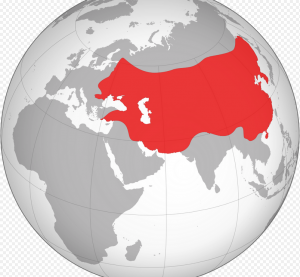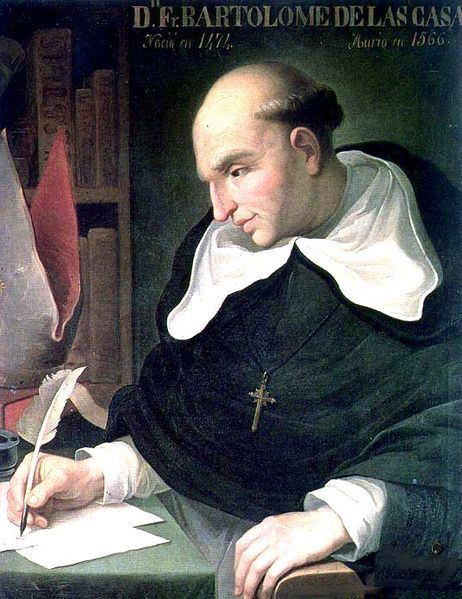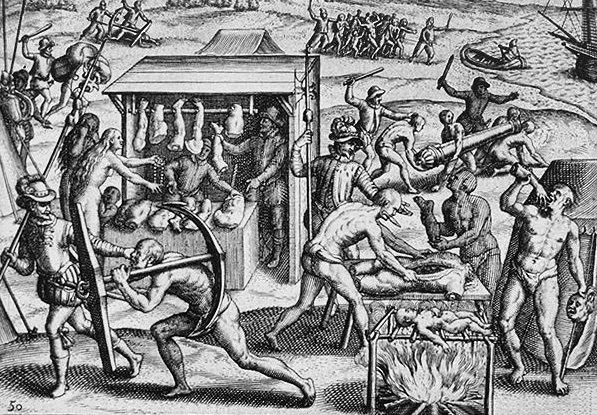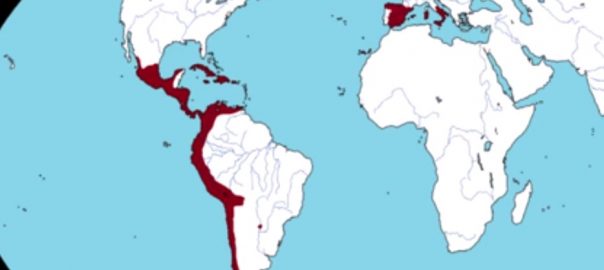In my 1541 post, I noted the centennial of Portugal’s introduction of the practice of European slave-raiding into sub-Saharan Africa. This year, 1542 CE, marks the first half-century of Spain/Castile’s massive empire-building project in the Americas. (See a rough map of its extent in 1542, above.) This year also marked some significant stirrings of conscience among a small segment of Spanish Catholics– though not enough to put more than a tiny dent in the continuing and still escalating depradations of the conquistadores in the “New World” they had found.
More on all that, below. Here’s what else was going on in the world:
- In Ethiopia, Portuguese and Ottoman-aligned forces fought several significant battles. In 1541, as we saw, the Portuguese Estêvão da Gama had landed a significant fighting force at Massawa on the Ethiopia/Eritrea’s Red Sea Coast. He himself didn’t hang around, but his brother Cristóvão da Gama stayed on land to lead the fighters, whose mission was to protect the Christian emperor of Ethiopia from Ottoman-aligned fighters loyal to the (Muslim) Adal Sultanate. In February, April, and early August, Cristóvão’s fighters fought and won three significant battles. He also hooked up– in military terms– with a feisty Ethiopian empress called Seble Wongel who commanded her own fighters. But in late August, the Adal general Imam Ahmad inflicted a big defeat on Cristóvão’s forces at the Battle of Wofla in today’s Tigray, and killed Cristóvão. (I find the accounts of Portugal’s many interactions with the Ottomans in and around the Arabian Sea really interesting. They will continue. Good to keep in mind that Portugal was able to sustain all this activity despite having ridiculously long supply lines all around the Cape of Good Hope…)
- Meantime, back home in Europe, Henry VIII had his fifth wife executed.
- Of greater impact: In July, by-now deeply Protestant Henry entered into a pact with Spanish King Charles V to declare war (again) on France. French King Francis 1 received some support from Scotland and more from Suleiman the Magnificent. Two features of the war that ensued were (1) the seizing of Nice, in the Mediterranean, from Spain, by a joint Franco-Ottoman fleet, and (2) an Anglo-Spanish invasion of northern France led by Charles V himself. Nothing got resolved in this war. But it did indicate that, for Charles as for Henry, realpolitik could outweigh religious affiliation…
- In August, a Scots-Catholic army defeated an English army at Haddon Rig. But in late November, an English army defeated a Scottish army at Solway Moss. Three weeks later, Scotland’s King James V died. His 6-day-old daughter Mary was named queen.
- The arrival of a Portuguese ship in Japan marked Japan’s first contact with any Europeans.
Spain’s conquista of the Americas at 50
In 1492 CE, Ferdinand and Isabella, whose marriage had combined the kingdoms of Castile and Aragon into the Spanish Kingdom, seized control of Granada, the last Muslim city-state in Iberia. They also dispatched the Genoese mariner Christopher Columbus to sail west into the Atlantic to find a route to the “East Indies” that would give them their own access to the long-reputed wealth of that part of the world, independent of both the Ottomans who controlled the land routes to East Asia and the Portuguese who even then were just starting to sail around the southern tip of Africa, into the Indian Ocean. The “Race for the Indies” was on! And how delighted they were when Columbus reported that he had in fact made contact with them…
Except, as soon became clear, what he had “discovered” was the island of Hispaniola and some other islands in the Caribbean. No matter. After early reports of Columbus’s discoveries got back to Castile, Ferdinand and Isabella (aka “the Catholic Monarchs”) were ready with broadly conceived plans to enact in their newly discovered “Indies” the kinds of plunder and control they and their forebears had already been undertaking for some centuries against all the highly developed Muslim city-states they had been able to capture in Iberia. One of their chief forms of settling/control was the encomienda, a system of mass enslavement of captured populations already well developed in Iberia. Moreover, piggybacking on the papal bulls that Pope Nicolas V had issued to the Portuguese (in re West Africa) forty years earlier, Spain’s Catholic Monarchs must have felt that they, too, had clear religious instructions to
invade, search out, capture, vanquish, and subdue all Saracens and pagans whatsoever …[and] to reduce their persons to perpetual slavery, and to apply and appropriate to [themselves and their] successors the kingdoms, dukedoms, counties, principalities, dominions, possessions, and goods, and to convert them to his and their use and profit…

The extent of what the Spanish achieved in the 50 years after 1492 had only two clear historical precedents: the speed with Islamic leaders built their empire in the 50 years after the death of the Prophet in 632 CE; and the speed with which horse-riding Mongol armies conquered most of the Eurasian landmass in the 50 years after Genghis Khan took power in 1206 CE.
By 1542 CE, the Spanish were in control of all the significant Caribbean islands, all of Central America, most of today’s Mexico, and the West coast of South America down to the middle of today’s Chile. And they were treating the Indigenous peoples whom they had encountered and subjugated there extremely badly. Their predecessors in the Muslim and Monghol hordes had fought hard for their conquests and treated their newly subjugated populations harshly at the outset; but the leaders of both those empires built governance systems of some durability– which required that they find a sustainable way for the subject peoples to live, work, and trade within the empire and thus help to make it prosper. One of the big differences for the conquistadores was that they carried out their rapacious and and brutal form of imperial control very far from the homeland. (An early form of “What happens in Vegas stays in Vegas”, perhaps…) Another was the relatively small numbers and poorly educated quality of the Spanish people they had in their speedily acquired colonies, given the difficulties of transporting Spanish administrators or settlers across the broad ocean in any significant mass. Sure, the emerging kingdom of “Spain” had numerous experienced administrators back home in Europe. But how many of those actually wanted to join the rough, dangerous booty-hunting expeditions across the ocean? A third was probably the sheer arrogance of the conquistadors’ combined belief in their own religious mandate to conquer and their general sense of “White”/Christian entitlement.
For whatever combination of reasons, the Spanish conquistadores practised a form of cruelty and barbarity against those they had conquered that far outlasted anything that might be called “the heat of battle.” (Though of course, when there were battles of resistance from the indigenes, whether in Peru, the Yucatan, or elsewhere, the retribution of the Spanish could be even more ferocious than the everyday brutality they practiced against them.)

One of the first to document this ill-treatment in a systematic way was a man called Bartolomé de las Casas, who was born in Seville in 1484. When he was 18, he and his father migrated to the the Spanish-held Caribbean island of Hispaniola. There, English-WP tells us, he,
became a hacendado and slave owner, receiving a piece of land in the province of Cibao.[15] He participated in slave raids and military expeditions against the native Taíno population of Hispaniola.[16] In 1510, he was ordained a priest, the first one to be ordained in the Americas.[17][18]
In September 1510, a group of Dominican friars arrived in Santo Domingo led by Pedro de Córdoba; appalled by the injustices they saw committed by the slaveowners against the Indians, they decided to deny slave owners the right to confession. Las Casas was among those denied confession for this reason.[19] In December 1511, a Dominican preacher Fray Antonio de Montesinos preached a fiery sermon that implicated the colonists in the genocide of the native peoples. He is said to have preached, “Tell me by what right of justice do you hold these Indians in such a cruel and horrible servitude? On what authority have you waged such detestable wars against these people who dealt quietly and peacefully on their own lands? Wars in which you have destroyed such an infinite number of them by homicides and slaughters never heard of before. Why do you keep them so oppressed and exhausted, without giving them enough to eat or curing them of the sicknesses they incur from the excessive labor you give them, and they die, or rather you kill them, in order to extract and acquire gold every day.”[20]
Las Casas himself argued against the Dominicans in favour of the justice of the encomienda. The colonists, led by Diego Columbus, dispatched a complaint against the Dominicans to the King, and the Dominicans were recalled from Hispaniola.[21][22]
So far, so ordinary for Bartolomé. In 1513, the first glimmerings of conscience. That year, he participated in a conquistador capture of Cuba, where he witnessed many atrocities committed by Spaniards against the native Ciboney and Guanahatabey peoples. He later wrote: “I saw here cruelty on a scale no living being has ever seen or expects to see.” Nothing daunted, though, when he was offered a new land grant (encomienda) in Cuba, which was described as “rich in gold and slaves” he took it, and for a year or so he divided his time between being a colonist and being a priest.
The following year, his mind was made up. He, “was finally convinced that all the actions of the Spanish in the New World had been illegal and that they constituted a great injustice. He made up his mind to give up his slaves and encomienda, and started to preach that other colonists should do the same. When his preaching met with resistance, he realized that he would have to go to Spain to fight there against the enslavement and abuse of the native people.”
He sailed back to Spain to seek an audience with the King, to try to persuade him to end the encomienda system. He had a brief meeting with the ageing Ferdinand in late 1515 and was promised a longer one; but the king died soon thereafter.

At that time, the people being worked as slaves in the Spanish colonies were all natives of the Americas. In his early advocacy work, Las Casas argued for lessening the suffering being inflicted on the indigenes (“Indians” as they were called)– by importing black slaves from Africa. His argument was that traditional Catholic “Just War” theory justified that. He had another idea, too: to build up a series of fortified towns on the north coast of Venezuela and bring “Indians” into them to live and work. (Strategic hamlets.) He then traveled to Venezuela to try to put that concept into practice, but his project of “peacefully” building these colonies collapsed in 1522 amidst fierce battles between Spanish conquistadores and Indigenous resisters that broke out all around him. (Read about that here.) He then fell back to Plan B. He entered a Dominican monastery, studied to become a Dominican friar, and then friared some around Hispaniola, Cuba, Guatemala, Panama, Nicaragua, and Oaxaca, continuing to argue against the gross abuses being visited on the Indians (including their forced and mass conversion to Catholicism.) In 1537, the arguments he was penning from Central America even persuaded Pope Paul III to issue a new bull that stated that Indians “were rational beings and should be brought peacefully to the faith.”
In 1540, he set off for Spain once again, determined to resume his campaign there, in the imperial heartland, to persuade King Charles to end the atrocities against the Indians. In 1542, he was invited to make his case at official hearings. (It’s unclear whether the king attended any, but senior court officials did.) Here’s how they went:
When the hearings started in 1542, Las Casas presented a narrative of atrocities against the natives of the Indies that would later be published in 1552 as “Brevísima relación de la destrucción de las Indias“. …[He] argued that the only solution to the problem was to remove all Indians from the care of secular Spaniards, by abolishing the encomienda system and putting them instead directly under the Crown as royal tribute-paying subjects.[58] On November 20, 1542, the emperor signed the New Laws abolishing the encomiendas and removing certain officials from the Council of the Indies.[59] The New Laws made it illegal to use Indians as carriers [porters], except where no other transport was available, it prohibited all taking of Indians as slaves, and it instated a gradual abolition of the encomienda system, with each encomienda reverting to the Crown at the death of its holders. It also exempted the few surviving Indians of Hispaniola, Cuba, Puerto Rico and Jamaica from tribute and all requirements of personal service. However, the reforms were so unpopular back in the New World that riots broke out and threats were made against Las Casas’s life. The Viceroy of New Spain, himself an encomendero, decided not to implement the laws in his domain, and instead sent a party to Spain to argue against the laws on behalf of the encomenderos…
So, not much success there, even with all the gradualism that Las Casas was arguing for.
The rest of his life was also pretty eventful. In 1551 he would take part in a famous public theological debate in Valladolid against empire- and slavery-supporter Juan Ginés de Sepúlveda. (Stay tuned for more on that.) Las Casas also wrote and published widely on the topics of his concern. What effect did his work have? I guess we’ll have to carry on with this project to find out…
